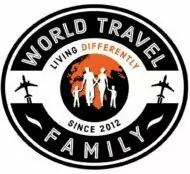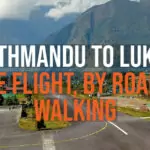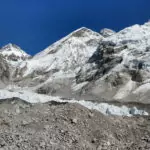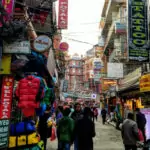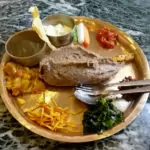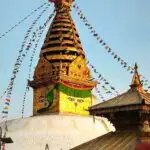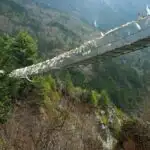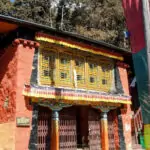Your packing list for the EBC trek will depend a lot on you, the time of year you are completing the EBC trek, and how much luggage you plan to take. Trekkers carrying their own gear will likely pack lite, those taking porters will pack far more. Below we have our EBC packing list to serve as a guide.
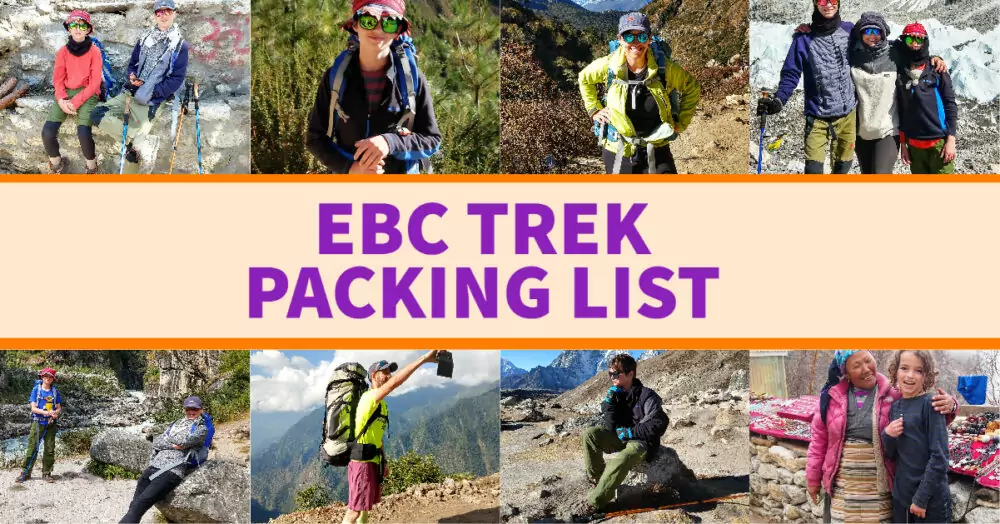
We have completed the EBC trek, trekked as far as Tengboche twice, and completed the Annapurna Circuit. We do not use porters, we carry everything ourselves. This is our packing list, we give reasons for our choices in what gear, clothing, and equipment, plus toiletries and medical kit, to pack.
This pdf EBC packing list is also available as a free, printable, downloadable sheet. You can use it as a check list as you assemble your gear for the EBC trek.
EBC Trek Packing List
We’ll break the EBC packing list down by gear type, what’s absolutely essential, and what’s not. We’ll add reasons for our choices and notes on time of year, trek type (group or independent) and so on.
EBC Trek Packing List Essentials.
The following items are absolutely essential. Do not even think of going to EBC or trekking in this region, without the following essential items.
All of these items will be packed into your trekking pack if you are hiking without a porter. If you take a porter, you can take more, but most of the items below should absolutely be in your day pack as you could need them during the day.
We make notes on how many of each item to pack as indicated.
- Comfortable boots or shoes suitable for mountainous terraine and potential wet and cold.
- Comfortable socks. We prefer thin socks at lower altitudes, serious trekking socks as it gets colder. At least 3 pairs.
- Dry socks for night-time (this can be your clean socks for the next day, or a special pair)
- Pants
- Long sleeved tops
- Waterproof jacket with hood.
- Warm down jacket or very thick fleece
- Underwear – but not everyone finds this essential!
- Lip balm with UV protection
- Sunscreen
- Sunglasses
- Hat, to keep sun off and for warmth at night and at high altitudes.
- Gloves
- A scarf or warm buff.
- A travel towel
- A water bottle and a way to purify water.
- Toilet roll or tissues.
- Antiseptic
- Toothbrush and paste
- Perscription medication.
- Vitamins/minerals/supplements.
- Glasses/ contact lenses/ contact solution.
- Sanitary protection
- Soap in a zip lock plastic bag
- Documentation and permits
- Cash
- Credit Cards
- A map
- Earplugs or cotton wool for the flight to Lukla
These are the only items that I would consider 100% essential on the EBC trek. I have done the EBC trek without a sleeping bag. You probably will want to take one.
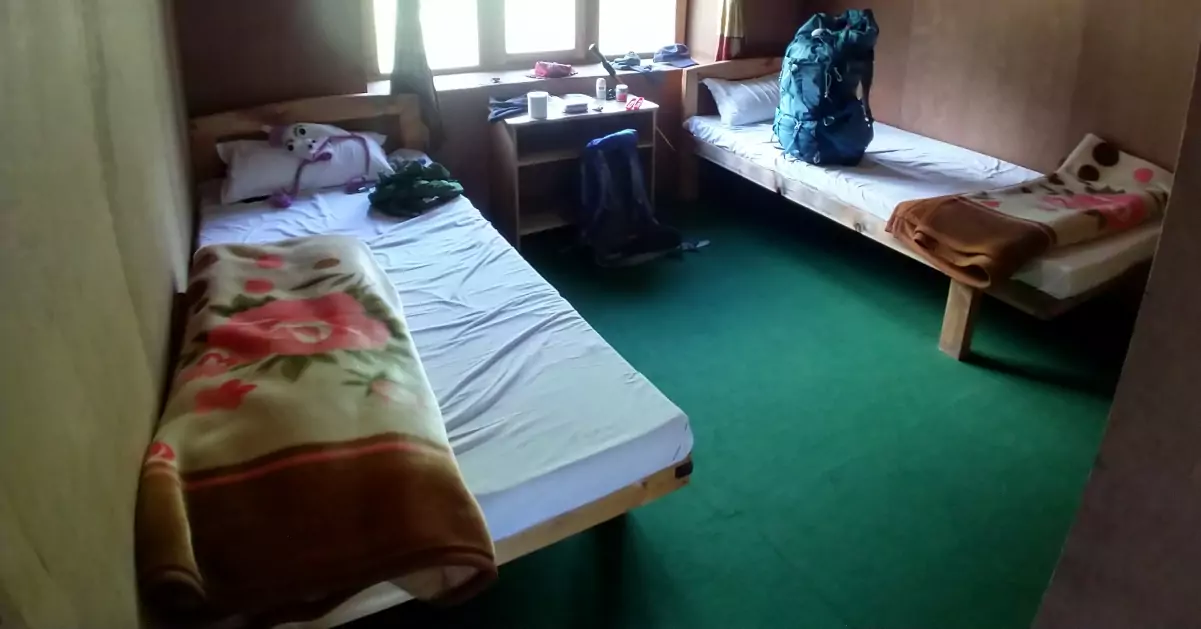
Normal people will take the following.
- a reliable four-season mummy sleeping bag with a hood.
- a sleeping bag liner if that bag is rented, or if, like me, you plan to risk not taking a sleeping bag.
Most lodges on the EBC trek provide thick, warm, blankets. I used these plus a fleece liner. These blankets are not very clean and tend towards itchy. But having been trekking in the Himalayas many times before, I knew what to expect, I was fine.
I knew that we’d be sleeping in most of our clothes every night anyway.
It is particularly important to be dry at night. If you’re sweaty or your clothes are damp, you will be cold. Towel off at the end of the day or consider changing into dry clothes. Your feet, in particular, will thank you for soft, dry socks.
On our last EBC trek, we needed our waterproof jackets for 10 minutes in 3 weeks. Even with a small risk of rain, I wouldn’t chance getting stuck in rain and getting wet. You get cold, fast.
As we trek independently we knew that we could always stop at the nearest lodge to ride out bad weather. Because of this, we didn’t take waterproof over-trousers. We were also trekking in October, peak season, known for blue skies and warm sunshine. We took the chance.
I would strongly recommend you do take waterproof over-trousers. Particularly if you are trekking with a group and to a set schedule. We had the luxury of unlimited time.
In winter, in snow, on the Annapurna Circuit, we needed our waterproofs for days in deep snow. We also needed our boots waterproof, plus gaiters to keep snow out. Gaiters should be easy to find in shops on the trek if you find you need them.
I haven’t included trekking poles on our “trekking essentials” list because when I was young I didn’t use them. Today I absolutely do use trekking poles. To me they are essential. They make walking easier and safer and protect your joints.
EBC Packing List, Complete List
We’ll take our EBC Essential, above, and add to it the non-essentials that will make for a much more comfortable trip.
- Comfortable boots or shoes suitable for mountainous terrain and potential wet and cold.
- Comfortable socks. We prefer thin socks at lower altitudes, serious trekking socks as it gets colder. At least 3 pairs.
- Dry socks for night-time
- Pants
- Long sleeved tops
- Waterproof jacket with hood.
- Warm down jacket or very thick fleece
- Underwear – but not everyone finds this essential!
- Lip balm with UV protection
- Sunscreen
- Sunglasses
- Hat, to keep sun off and for warmth at night and at high altitudes.
- Gloves
- A scarf or warm buff.
- A travel towel
- A water bottle and a way to purify water.
- Toilet roll or tissues.
- Antiseptic
- Toothbrush and paste
- Soap in a zip lock plastic bag
- Perscription medication.
- Vitamins/minerals/supplements.
- Glases/ contact lenses/ contact solution.
- Sanitary protection
- Documentation and permits
- Cash
- Credit cards
- Cash
- A map
- Earplugs or cotton wool for the flight to Lukla
- A reliable four season mummy sleeping bag with hood.
- A sleeping bag liner if that bag is rented, or if, like me, you plan to risk not taking a sleeping bag.
That’s the end of our “essentials” list, now add the following “optional” items as you see fit. You could keep adding endless gear for trekking, people do take some weird stuff up there!
The most important piece of trekking equipment is your footwear, followed by your pack. Then add trekking poles.
- A belt, possibly an anti-theft security belt with money concealing pocket. Be aware that belts can be uncomfortable for trekking or hiking.
- Spare sunglasses. You really don’t want snow blindness.
- Clean sarong, travel pillow, or pillow cover for hygiene in lodges
- Comfortable dry shoes for use in lodges*
- Trekking poles
- Head torch with spare battery or USB charger
- Trekking watch
- Waterproof cover for your trekking pack (ideally built-in)
- Crampons for certain add-on treks in EBC region and possibly on the final days of the trek.
- Rubber thongs or flip flops to use in showers
- Floss
- Shampoo
- Conditioner
- Secure strap for sunglasses
- Face wash
- Body lotion
- Moisturiser
- Makeup
- Shaving cream
- Razors
- Tweezers
- Nail clippers or scissors
- Perfume/fragrance/cologne (unnecessary)
- Deodorant
- Paracetamol
- Motion sickness medication for the bus/plane
- Plasters/band aids
- Hand sanitiser
- A travel adapter plug for Nepal
- Camera
- Spare camera battery
- Gopro
- Tripod or mini tripod
- Gimbal
- Cables and chargers
- Phone
- Kindle
- Sleep mask/ear plugs
- Packing cubes
- Dirty laundry bag
- Wet bag
- Shoe bags
- Backup battery packs/power banks
- Photocopies of important documents
- Diamox
- Plastic bags
- Soap dish (or plastic bag) for soap and liquids.
- Wipes
*It is not necessary to pack additional shoes to use in lodges. We only ever take our trekking boots. I’ve read other posts where the author suggests woollen bootees to use in lodges at night. Once you’ve seen the toilets you’ll realise what a bad idea this is. We simply lace our boots very loosely to slip on and off easily and to help them dry out in the evenings/ at night. A pair of clean and dry night-time socks is a very good idea though. I’ve packed wool leg warmers, these are great to pull down over your feet at night too. A pair should cost you a dollar or two in Kathmandu or Namche Bazaar.
I’ve added more notes on these luxury items further down the page.
What Clothing to wear on the EBC trek?
If you look at suggested EBC trek packing lists from the big travel companies you’ll see mention of merino base layers, thermal this and that, mid-layers, outer layers, and your waterproof outer shell. You don’t need to follow the marketers’ suggestions.
As you can see in our photos at the top of the page, we went to Everest Base Camp, and elsewhere in the Himalayas, in our regular street clothes, applied in layers, with a few important modifications.
Running and sportswear is very useful on the EBC trek. My husband wore running shorts and long compression socks for the first few days before layering leggings under his shorts.
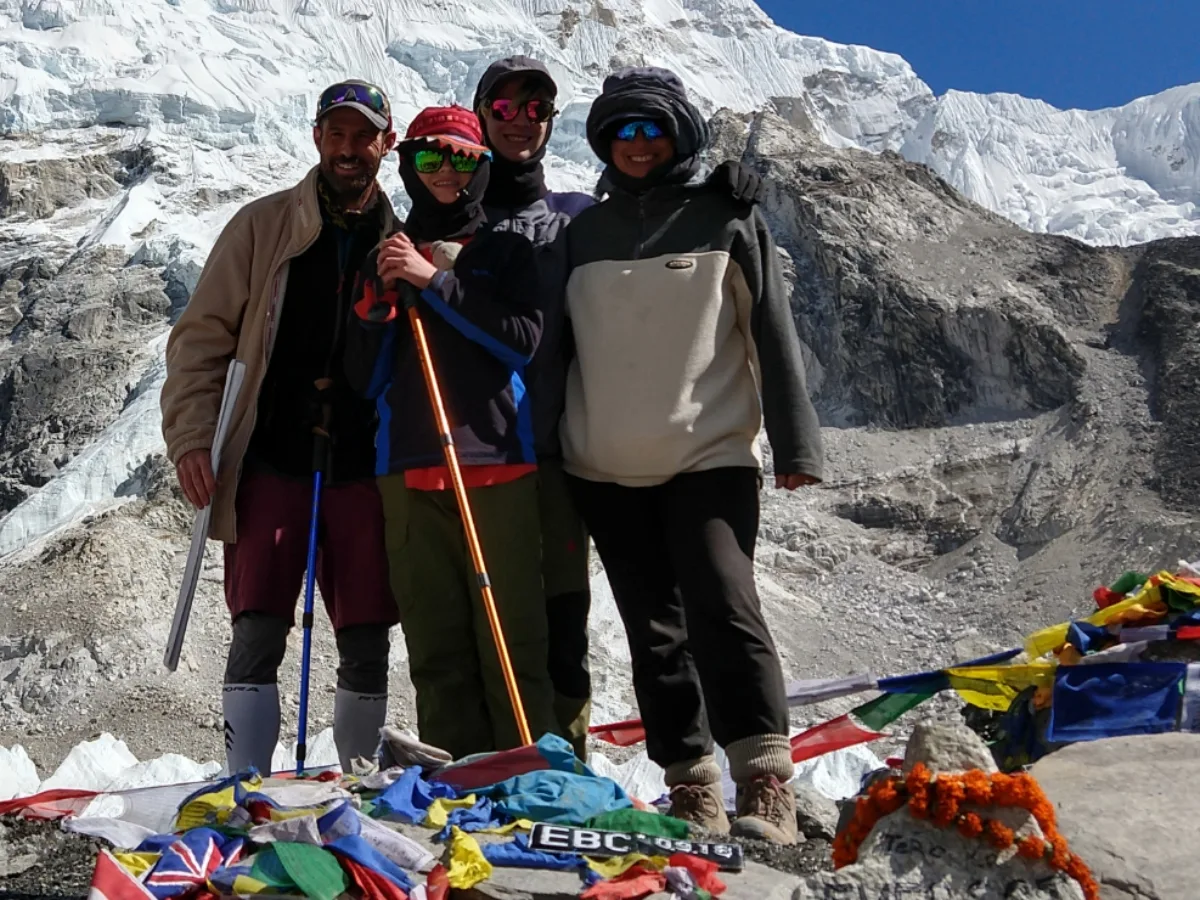
We trekked in running tights, jeans and yoga pants. The kids had leggings under their thin trekking pants at high altitudes. We wore T shirts fleeces, buffs and sun hats. Wind-proof, water-resistant gloves are a must, as is a waterproof jacket with a hood you can tighten, even if you don’t expect rain or snow, I would never risk a trek without a wind and water-proof jacket. A thick fleece kept me warm enough on this trek in October. In winter, I take a good down jacket. A warm hat and scarf are essential as are dry socks to wear at night and in bed. We’ve never owned thermals nor merino base layers. You know your body and your comfort levels, but don’t cut corners and put yourself in danger and don’t over-pack and ruin your hike with an over-heavy pack.
Taking Kids on EBC Trek Packing List
We do not, at all, recommend taking young children on the EBC trek. It’s too dangerous. That said, our kids made it to Everest Base Camp at 12 and 14. It was fine for us with tweens and young teens.
We’ve taken our kids to Nepal many times and they love this amazing little country.
If you’re taking kids into the Himalayas you’ll need to be ultra-careful that they are warm and dry and that their extremities are protected. They also may not alert you to early warning signs of mountain sickness.
Keep them close, ideally, hold onto them. Yaks and donkeys, along with potential rock or mudslides are real hazards.
The kids will need everything the adults will need to stay warm and dry, plus extras such as:
- Nappies/diapers
- Nappy creams
- Wipes
- Kids medications
- Special comforters
- Familiar snacks or foods
- Plastic cup or bottle
- Own cuttlery if needed
- Kindles, electronics, even more need for power packs.
- Rehydration salts
We recommend taking a guide and/or porter if you really plan to take younger children on the EBC trek. My 14-year-old carried a very light pack, my 12-year-old didn’t carry a pack. It was enough for him just walking without a few extra kilograms to carry.
Do you need to pack snacks for the EBC trek?
If you are a person who finds they need to snack regularly, take snacks. If not, take an emergency snack anyway. It’s good to have something like a peanut and chocolate bar in your daypack, just in case your blood sugar drops or you feel unwell. Remember that snacks are extra weight that you will have to carry. There are many shops along the route which sell snacks such as well-known chocolate bars, however, sometimes it can be a good distance between shops. As you gain altitude, prices rise, but we feel that it’s not worth the extra weight to pack snacks to offset how expensive they are.
Should you use packing cubes on the EBC trek?
No, packing cubes are not a good idea where weight is a major packing consideration. Packing cubes can make your packing more organised but when you’re carrying everything on your back, lightening your load is more important. Ultra-light packing cubes are available if you really need to be organised, but most trekking packs will have internal pockets of some sort. If you’re trekking with a porter it would still be better to not use them, we feel.
How many pairs of socks to take on the EBC trek?
3 is the minimum number of socks to take on the EBC trek. This allows one to wash, one to wear, one spare. We recommend taking more. Having a dry pair of socks to put on clean, dry feet at the end of the day will keep them warmer and fresher. Washing and drying socks on the trek is hard to do. You will have to tie socks to the outside of your pack to dry them and accessing warm water for washing is hard. We have seen laundry service in Namche Bazaar, but on a group trek you may not have time to arrange this. Take as many socks as you can comfortably carry on your back. The more socks you have, the easier your trek will be. We even discard used socks and other clothing on the trek to lighten the load.
That’s our take on what to pack for the EBC trek. But we’re not you. Tell me, what other essentials would you pack for your trek?
If you'd like to hire a car during your stay, use this car rental comparison tool to find the best deal!
We also suggest you take a look at this company to get a quote for all kinds of the more tricky adventure or extended travel insurance.
Try Stayz / VRBO for an alternative way to find rentals on homes/apartments/condos in any country!
